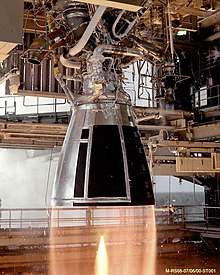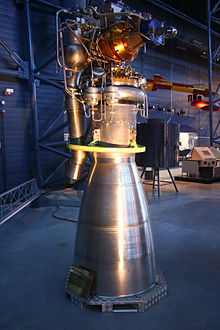
Back محرك صاروخي Arabic Motor cohete AST Ракетен двигател Bulgarian Raketni motor BS Motor de coet Catalan بزوێنەری مووشەک CKB Raketový motor Czech Raketmotor Danish Raketentriebwerk German Motor cohete Spanish


A rocket engine uses stored rocket propellants as the reaction mass for forming a high-speed propulsive jet of fluid, usually high-temperature gas. Rocket engines are reaction engines, producing thrust by ejecting mass rearward, in accordance with Newton's third law. Most rocket engines use the combustion of reactive chemicals to supply the necessary energy, but non-combusting forms such as cold gas thrusters and nuclear thermal rockets also exist. Vehicles propelled by rocket engines are commonly used by ballistic missiles (they normally use solid fuel) and rockets. Rocket vehicles carry their own oxidiser, unlike most combustion engines, so rocket engines can be used in a vacuum to propel spacecraft and ballistic missiles.
Compared to other types of jet engine, rocket engines are the lightest and have the highest thrust, but are the least propellant-efficient (they have the lowest specific impulse). The ideal exhaust is hydrogen, the lightest of all elements, but chemical rockets produce a mix of heavier species, reducing the exhaust velocity.
Rocket engines become more efficient at high speeds, due to the Oberth effect.[1]
- ^ Hermann Oberth (1970). "Ways to spaceflight". Translation of the German language original "Wege zur Raumschiffahrt," (1920). Tunis, Tunisia: Agence Tunisienne de Public-Relations.
© MMXXIII Rich X Search. We shall prevail. All rights reserved. Rich X Search